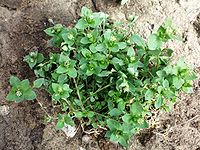- Stellaria media
-
Common chickweed 
Flowers of the common chickweed Scientific classification Kingdom: Plantae (unranked): Angiosperms (unranked): Eudicots (unranked): Core eudicots Order: Caryophyllales Family: Caryophyllaceae Genus: Stellaria Species: S. media Binomial name Stellaria media
(L.) Vill.Synonyms Alsine media L.
Stellaria Apetala Ucria ex Roem.Stellaria media, common chickweed, is a cool-season annual plant native to Europe, which is often eaten by chickens. It is commonly also called Chickenwort, Craches, Maruns, Winterweed. The plant germinates in fall or late winter, then forms large mats of foliage. Flowers are small and white, followed quickly by the seed pods. This plant flowers and sets seed at the same time.
Contents
Growth
In both Europe and North America this plant is common in gardens[1], fields, and disturbed grounds. Control is difficult due to the heavy seed sets. Common Chickweed is very competitive with small grains, and can produce up to 80% yield losses among barley.[2]
Uses
Stellaria media is edible and nutritious, and is used as a leaf vegetable, often raw in salads.[3] It is one of the ingredients of the symbolic dish consumed in the Japanese spring-time festival, Nanakusa-no-sekku.
Folklore
The plant has uses in folk medicine. For example, 17th century herbalist John Gerard recommended it as a remedy for mange. Modern herbalists mainly prescribe it for skin diseases, and also for bronchitis, rheumatic pains, arthritis and period pain. A poultice of chickweed can be applied to cuts, burns and bruises. Not all of these uses are supported by scientific evidence.[4]
Distribution and Identification
Stellaria media is widespread in North America from the Brooks Range in Alaska to all points south within North America. There are several closely related plants referred to as chickweed, but which lack the culinary and medicinal properties of plants in the genus Stellaria. Plants in the genus Cerastium are very similar in appearance to Stellaria and are in the same family (Carophyllaceae). Stellaria media can be easily distinguished from all other members of this family by examining the stems. Stellaria has fine hairs on only one side of the stem in a single band. Other members of the family Carophyllaceae which resemble Stellaria have hairs uniformly covering the entire stem.
See also
References
Notes
- ^ Neltje, Blanchan (2005). Wild Flowers Worth Knowing. Project Gutenberg Literary Archive Foundation.
- ^ A. Davis, K. Renner, C. Sprague, L. Dyer, D. Mutch (2005). Integrated Weed Management. MSU.
- ^ Stellaria media at Plants for a Future
- ^ Howard, Michael (1987). Traditional folk remedies : a comprehensive herbal. London: Century. p. 119. ISBN 0712617310.
General references
- Gregory L. Tilford, Edible and Medicinal Plants of the West, ISBN 0-87842-359-1
Further reading
- Everitt, J.H.; Lonard, R.L., Little, C.R. (2007). Weeds in South Texas and Northern Mexico. Lubbock: Texas Tech University Press. ISBN 0-89672-614-2
External links
Categories:- Stellaria
- Garden plants of Europe
- Flora of the Antipodes Islands
- Garden plants of New Zealand
- Medicinal plants
- Caryophyllales stubs
Wikimedia Foundation. 2010.

